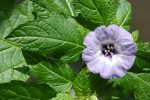 Also known as apple of Peru, apple of Sodom, Peruvian bluebell, this annual is native to northwest Argentina, Bolivia, north and central Chile, and Peru where it grows in disturbed sites and waste areas. It is a member of the nightshade family, Solonaceae, that also includes potato, tomato, and eggplant. The plants grow up to 4′ tall and have spreading branches bearing ovate, mid-green leaves with toothed margins. In summer 2″ wide bell-shaped flowers appear and may be blue and white, violet, or white. They remain open for only a couple of hours each day and at the end of the bloom period each flower gives way to a green lantern-like fruit resembling the inflated fruits of Chinese lantern. Unlike Chinese lanterns, however, the fruits split open to reveal a shiny brown ball of seeds. Plants are grown to add interest to a border or for the fruits which dry well. Since the seeds of shoo-fly plant are often included in bird seed mixes, plants pop up unexpectedly in gardens and can become weedy. The genus name, Nicandra, honors an ancient Greek scientist, Nycander, who wrote treatises on plants over 2000 years ago. The species name, physalodes, comes from the Greek words eidos meaning form, and physallis, meaning bladder, and refers to the resemblance of the fruit to the bladder-like fruit of the genus Physalis, the Chinese lantern and tomatillo.
Also known as apple of Peru, apple of Sodom, Peruvian bluebell, this annual is native to northwest Argentina, Bolivia, north and central Chile, and Peru where it grows in disturbed sites and waste areas. It is a member of the nightshade family, Solonaceae, that also includes potato, tomato, and eggplant. The plants grow up to 4′ tall and have spreading branches bearing ovate, mid-green leaves with toothed margins. In summer 2″ wide bell-shaped flowers appear and may be blue and white, violet, or white. They remain open for only a couple of hours each day and at the end of the bloom period each flower gives way to a green lantern-like fruit resembling the inflated fruits of Chinese lantern. Unlike Chinese lanterns, however, the fruits split open to reveal a shiny brown ball of seeds. Plants are grown to add interest to a border or for the fruits which dry well. Since the seeds of shoo-fly plant are often included in bird seed mixes, plants pop up unexpectedly in gardens and can become weedy. The genus name, Nicandra, honors an ancient Greek scientist, Nycander, who wrote treatises on plants over 2000 years ago. The species name, physalodes, comes from the Greek words eidos meaning form, and physallis, meaning bladder, and refers to the resemblance of the fruit to the bladder-like fruit of the genus Physalis, the Chinese lantern and tomatillo.
Type: Annual
Bloom: Bell-shaped flowers 2″ wide with blue or white petals and a white throat, in summer
Size: 4′ H x 1′ W
Light: Full sun
Soil: Average, moderately moist, well-drained
Hardiness: Not hardy
Care: Low maintenance
Pests and Diseases: None of significance
Propagation: Seed
Companion Plants: Garden phlox, Aster umbellatus, Coreopsis major
Photo Credit: Boronian, Wikipedia